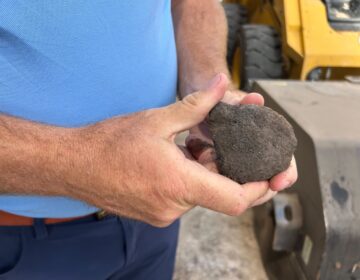This shower is a mere trickle
ListenLeonid Meteors are visable late tonight into dawn tomorrow, although Leonids are a weak shower. Other night sky treats include: Mars early in the evening, Orion rises at 8 p.m., Jupiter late in the evening, 11:30 p.m. Moon also visible in the pre-dawn sky this week. Mercury very low in the east at 6 a.m. Last week’s European Space Agency Rosetta mission adds comets to out-of-this-world sites where photos have ben taken on landing – Moon, Venus, Mars, Titan, asteroid Itokawa.
November 17, 2014
[Dave Heller] The Rosetta satellite successful 4 billion mile sojourn over 10 years to land on a 2.5 mile-wide comet is the latest marvel melding science, technology and the tenacity of those involved with the project. Let’s get perspective with Derrick Pitts, chief astronomer at the Franklin Institute. And Derrick, that perspective comes in the growing list of out-of-this-world sights that have been taken and transmitted back to Earth.
[Derrick Pitts] We’ve been able to land space probes on some very interesting locations and take incredible images. And I know most people are familiar with, you know, the work we’ve done on the moon, the work we’ve done on Mars — yeah, you know, all those sort of old hat things. But we should keep in mind that it was decades ago when Russian landers — the Venera series — landed on the surface of Venus and took pictures of the Venusian surface. That was an incredible accomplishment for the 1970’s.
In part because that surface is typically shrouded.
It is shrouded and it is not a nice place at all. Here we have a highly reductive atmosphere, the pressure is incredible, the temperature is very high, and it’s remarkable that the spacecraft will continue to operate for as long as it did. Long enough to get us a photograph of the surface of Venus. We’ve also landed spacecraft on the surface of Saturn’s largest moon Titan and got an incredible image of that location as well. The spacecraft again landing in a very, very nasty environment where the temperature is nearly 300 degrees below zero, lakes of liquid methane, yet the spacecraft operated for at least an hour. And we only stopped uploading information from it after the parent spacecraft flew over the horizon of Titan and could no longer get a signal from the lander on the surface. We’ve also landed spacecraft on the asteroid Itokawa. This was the Hayabusa mission run by the Japanese space agency and just a few years ago, they had a lot of the very same problems that the Philae lander has been seeing also. The idea of being able to land one fall, rather than bouncing across the surface before it could really get a good foothold on the asteroid itself.
Derrick, this is the first time we’ve landing on a comet. The data that’s coming back — will it help us determine whether or not perhaps water and perhaps life were seeded from outer space?
Even though it’s a sample of one, the information that we collect will give us a lot of general information about comets that will be extraordinarily useful because the data collected can confirm what we’ve been able to observe remotely. It’s like boots on the ground, it’s the real on-the-ground data that confirms what we’ve been able to see from afar. So that’s truly important. The question of whether or not we can apply that to the issue of where water came from originally in the solar system, whether or not the organics found were possible seeds for life on Earth — we’ll need more samples. But again — we’re able to confirm what we’ve been able to learn from afar and that is a very, very big jump. It’s as if we’re being able to go to the location and actually scoop up the substance that’s there and use that to tell us yes — we’re on the right track. We can use this as a learning experience to help us in the future with landing on other comets in the future. And thereby being able to add to the data points that we have about those important issues of the origins of life.
-

The combination photo of different images taken with Philae’s CIVA camera system released by the European Space Agency ESA on Nov. 13, 2014 shows Rosetta’s lander Philae as it is safely on the surface of Comet 67P/Churyumov-Gerasimenko, Philae landed Nov. 12, 2014 next to a cliff that largely blocked sunlight from reaching its solar panels on the comet. The head of the European comet mission says scientists will listen for signals from the Philae lander Saturday Nov. 15, 2014 but think it is unlikely they will establish any kind of communication soon. Controllers at the European Space Agency on Friday ordered the lander to perform a maneuver intended to pull it out of a shadow on the comet so that solar panels could recharge the depleted batteries. “We don’t know if the charge will ever be high enough to operate the lander again,” Paolo Ferri, ESA’s head of mission operations, told The Associated Press. (AP Photo/ESA)
Derrick, let’s dress warm and head out of doors. What’s available to be seen in the night sky?
In the early evening we can still see Mars in the southwestern portion of the sky; it’s hanging there really nicely. While over on the eastern side of the sky at 8 p.m., the winter constellation Orion is coming up above the horizon. If we stay out a bit later, out til 11:30 or midnight, we can see Jupiter rising above the eastern horizon. And that’s great, because we’ll be able to observe Jupiter as it rises earlier and earlier every week, making its way into the early evening skies; by December and January it’ll be a more comfortable time to observe. This week the moon is also visible in the pre-dawn sky — looks great over on the eastern horizon. And we find that Mercury is very, very low on the east around 6 a.m. — it’s going to be a tough observation, but if you can catch it, it’s rewarding.
-

Winter constellations. Photo by Flickr user Astronomy Calgary
We touched on it last week, but tis the time to check out the Leonids.
Indeed it is! Tonight is our best bet for the Leonid meteor shower. This isn’t a really intense meteor shower. In fact, few meteor showers during the course of the year are really intense. But just the same — if you happen to be out between 11 p.m. and sunrise tomorrow morning, we’ll be able to see a few of these objects coming in to us from the east, northeast. That’s where the radiant is from the constellation Leo. It’s a spring constellation but rising very, very late at night now. But in an urban environment, it’s a much bigger challenge because of the proliferation of city lights at night.
With a good clear sky, you’re apt to see meteors on any given night. How do you know when it rises above the threshold and that it’s indeed a Leonid?
That is a really great question, Dave, and it is that the background rate for meteors is a standard, normal background rate of space junk — natural space junk, if you will — falling into the Earth’s atmosphere shows us meteors at a rate of about 10 per hour. The Leonids brings us to a whopping 15 per hour — not all that big a jump at all. So a major meteor shower of about 60 to 90 to over 100 — that is a big meteor shower. Now in the case of a meteor shower like the Leonids, the way you’d guess that it actually is a member of the Leonid shower is to look at its trajectory. If its trajectory across the sky can be traced backwards towards an origin point and that origin point is in the vicinity of the constellation Leo the Lion, you can then identify that object as having been a member of the Leonid meteor shower, most likely.
-

Leonid meteor shower. Photo by Flickr user starhunter.net
WHYY is your source for fact-based, in-depth journalism and information. As a nonprofit organization, we rely on financial support from readers like you. Please give today.




